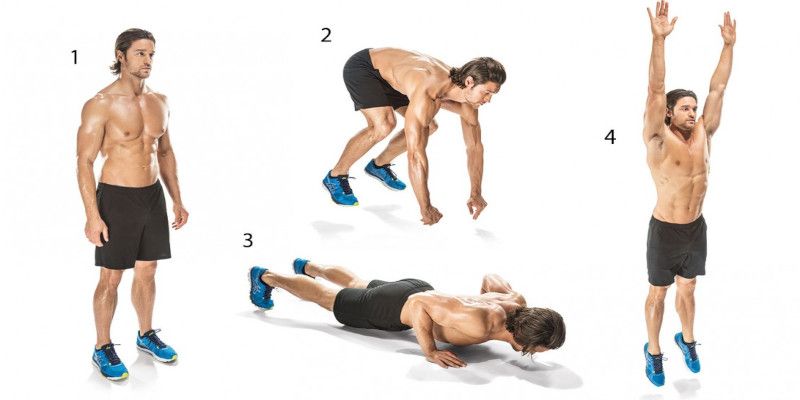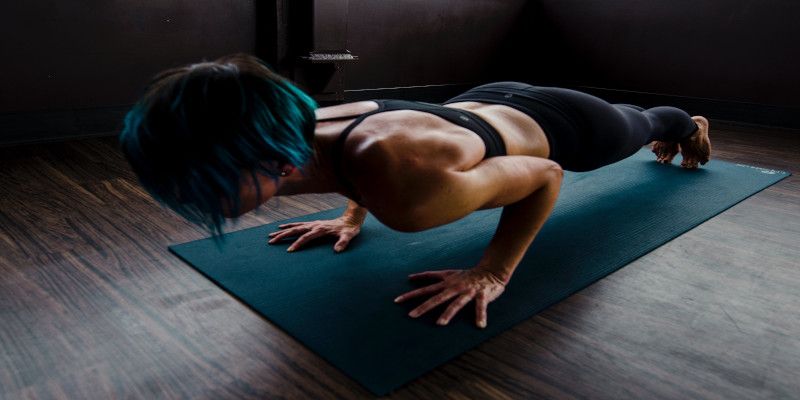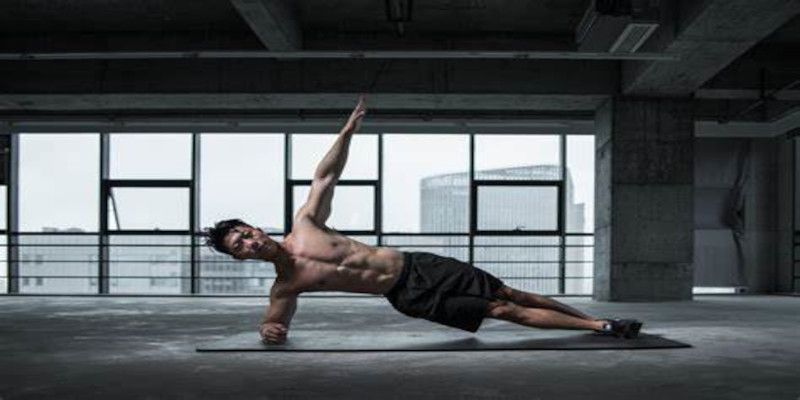Table of Contents
ToggleWorkout guidelines
Workout time:
Workouts per week:
Rest time between sets:
Training level:
Exercises performed:
Equipment:
Program goal:
25 minutes
2, preferably 3 times per week
30–60 seconds (beginner 60 sec vs. intermediate 30 sec)
Intermediate/advanced
Mountain climbers, lunges, Bulgarian lunges, pushups, single leg squats, squats, burpees, step-ups, planking, side planks, sit-ups, Crunches
Bench/box
Diet, cardiovascular improvement, strength
Why a 25 minutes intermediate circuit training workout?

It is possible to get in shape without having to lift heavy weights in the gym every day. A lot of people get burned out and spent from going to the gym day in and day out, doing the same routine every day and often, for years. This is why I advocate switching up your training routine sometimes.
Working out at home, performing a hard full-body circuit training workout, is both challenging and fun. The reasons? Being able to fit 25 minutes of circuit training into someone’s schedule can easily be done. If your goal is to get in shape, whether it is for the summer or just to be more fit overall, then it means this workout might be suited for you.
Research and my own experience have shown that high-intensity interval training (HIIT) works great and is quite possibly the best regarding fat loss. This means that a short but intense workout is better at burning calories and, thus, losing fat rather than spending countless hours doing low-intensity cardio workouts for fat loss. Like, for example, running or walking for an hour.


This 25-minute intermediate circuit training workout also has the added benefit of increasing your cardiovascular health and efficiency.
This means that we can use this intermediate circuit training HIIT workout to transform our bodies in only a small amount of time for the better. In turn, we feel better, look better, and get more fit.
Who said every workout needs to last for hours to be effective?
The possibility to easily alter the program from beginner to intermediate as you get more advanced as a trainee is also an added advantage that a lot of people will appreciate out of convenience. Just changing a couple of exercises, reducing rest time, and/or increasing the intensity is already enough to make this program much harder.
The 25 minutes intermediate circuit training workout program



In the intermediate program, we perform each exercise for 30 seconds, followed by one minute of rest.
All exercises are performed in chronological order. When the circuit is done, take two minutes of rest and repeat the routine another time.
If the intermediate HIIT routine is not challenging anymore then I would recommend switching over to the advanced program to keep improving your overall fitness and health level. Remember that standing still is the same as going backward!
Intermediate circuit:
- Mountain climbers
- Lunges
- Push-ups
- Squats
- Burpees
- Step-ups
- Planking
- Sit-ups
→ Repeat this routine 2x
The intermediate circuit training workout exercises explained
Mountain climbers


This exercise is performed by starting in the starting position of a push-up. Create tension in your core and proceed to lift your left foot and draw your left knee to your chest. Put the left foot down behind your hands, and then put your left foot back in the starting position. Next, do the same with the right foot and keep alternating between the two legs.
→ For beginners, placing both of your hands up a step and just bringing both knees up to your chest separately will be a lot easier.
If you find normal mountain climbers too challenging, then I recommend switching to this alternative form.
Lunges


Start by placing both feet next to each other.
Lift your left foot and place it down in front of you, proceed to perform a controlled bent in your left knee as far as you can and return to the starting position. Following this, you proceed to do the same with the right leg. Alternate between your left and right leg.
→ Make sure to keep your entire front foot on the ground when you’re bending the front knee. This will help with balancing and reducing the stress placed on the knee joint.
Push-ups




Start in a planking position with your hands positioned under your shoulders. Your body should be kept straight with your back properly aligned. This means without bending your back.
Lower your chest to the ground and come back up again by extending your elbows. Your elbows should be kept against your body when performing the exercise, so don’t flare your elbows out.
→ If regular push-ups are too hard, I recommend switching to an alternate form of push-ups. Instead of regular push-ups, let your knees rest on the ground. Keep your back straight to prevent back injuries, and don’t flare your elbows out.
Squats:


First, stand with both your feet at shoulder width.
Next, bend your knees while pushing your knees slightly outwards while keeping your back straight. Make sure to squat below parallel. This means your hips should be lower than your knees.
Now straighten your knees and make sure they keep pointing slightly outwards. Finally, fully extend your knees and hips.
Burpees


Stand up straight with your feet at shoulder width and perform the downward movement of a squat.
Now place both hands in the push-up position and hop both your feet backward in a planking position.
Next, hop both feet back to the front, behind your hands.
Lastly, jump up with both arms straight in the air.
→ For beginners or people with bad joints, the hopping part of the burpees might be too hard or taxing to perform. You can walk your feet forward and backward instead of hopping if this is the case.
Step-ups:


Stand with both feet next to each other in front of the stairs or a bench and place your left foot up the stairs.
Push up by extending your left knee and place your right foot on the stairs as well.
Step back off the stairs with your left foot going down first. Next, place your right foot down as well.
Proceed to alternate which foot is placed on and off the stairs first.
Planking:






Bear your weight on your toes and both your forearms.
Your back should be kept straight and your core tight. Proceed to hold this position.
→ An alternative way to perform this exercise is with both your hands placed in the push-up position. This will engage your triceps more.
Sit-ups:




Lie flat on your back with both feet resting on the ground. Place both arms crossed in front of your body and come upwards with your torso.
→ Be careful not to come upwards too much, if you come too high from the ground with your torso, then your back will start to bend. This places stress on the back discs, potentially leading to an injury.
Also, don’t put your hands behind your head, as some people will start pulling their heads when performing the upward motion. Potentially injuring their neck in the process.
The 25 minutes advanced circuit training workout program


Each exercise is performed for 45 to 60 seconds, depending on your fitness level. After finishing your exercise, take 30 seconds of rest and proceed to perform the next exercise.
If the program gets too easy, you can make it harder by decreasing the rest time between the exercises or performing the exercises with weights.
Intermediate circuit:
- Mountain climbers
- Bulgarian lunges
- Push-ups
- One-legged squats
- Burpees
- Step-ups
- Side planking
- crunches
→ Repeat this routine 2x
The advanced circuit training workout exercises explained
Mountain climbers
This exercise is performed by starting in the starting position of a push-up. Create tension in your core and proceed to lift your left foot and draw your left knee to your chest. Put the left foot down behind your hands, and then put your left foot back in the starting position. Next, do the same with the right foot and keep alternating between the two legs.
→ For beginners, placing both of your hands up a step and just bringing both knees up to your chest separately will be a lot easier.
If you find normal mountain climbers too challenging, then I recommend switching to this alternative form.
Bulgarian lunges
Start by placing your right foot in an elevated position behind you. (For example, on a box or a step.)
Proceed to perform a controlled bent in your left knee as far as you can go and return to the starting position.
Following this, you proceed to do the same with the right leg.
Alternate between the left and right leg.
→ Make sure to keep your entire front foot on the ground when you’re bending the front knee. This will help with balancing and reducing the stress placed on the knee joint.
Push-ups


Start in a planking position with your hands positioned under your shoulders. Your body should be kept straight with your back properly aligned. This means without bending your back.
Lower your chest to the ground and come back up again by extending your elbows. Your elbows should be kept against your body when performing the exercise, so don’t flare your elbows out.
→ Keep your back straight to prevent back injuries.
One-legged squats
Stand on your right foot while your left knee is bent with your left leg slightly backward. This means your left foot is not touching the ground at the start or during the entire movement. This is our starting position.
Bend your right knee while keeping your back straight. Make sure to squat below parallel. This means your hips should be lower than your knees.
Now extend your right knee and make sure your right knee keeps pointing slightly outwards.
Finally, fully extend your right knee and hip.
Alternate between your left and right leg.
Burpees
Stand up straight with your feet at shoulder width and perform the downward movement of a squat.
Now place both hands in the push-up position and hop both your feet backward in a planking position.
Next, hop both feet back to the front, behind your hands.
Lastly, jump up with both arms straight in the air.
Step-ups
Stand with both feet next to each other in front of the stairs or a bench and place your left foot up the stairs.
Push up by extending your left knee and place your right foot on the stairs as well.
Step back off the stairs with your left foot going down first. Next, place your right foot down as well.
Proceed to alternate which foot is placed on and off the stairs first.
→ While this seems easy, you can make it harder by stepping up on a higher box or performing your steps at a faster rate.
Side planking


Start on your left side, keep your legs and core straight, and place your left arm right below your shoulder. Bear weight on the side of your left foot and your left arm.
Proceed to lift your hips from the ground while engaging your core muscles. Your back and core should be kept straight and tight. Proceed to hold this position.
Alternate between your left and right side.
Crunches
Lie flat on your back with both feet on the ground. Your knees are bent at about 90°.
Place both arms crossed in front of your body and come upwards with your torso.
→ Be careful not to come upwards too much, if you come too high up from the ground with the torso, your back will start to bend. Placing stress on the back discs potentially leads to an injury.
Furthermore, don’t put your hands behind your head as some people will start pulling their heads when performing the upward motion which can, again, potentially result in a neck injury.
What is the difference between the intermediate and advanced circuit training workout?


The difference lies in the selection of exercises, and/or the training intensity.
This means that the advanced program will feature a longer training time and/or lower rest times than compared to our intermediate circuit training workout.
Our intermediate workout for example utilizes mostly basic, easy-to-perform exercises and movements where the need for advanced balancing skills is reduced when compared to our advanced training program.
We accomplish this by including exercises in the program that provide a stable base with a more bearing surface. For example: A two-legged squat is easier to perform than a single-leg squat. Even if you reduced the weight by half compared to your two-legged squat.
The single-leg squat leads to greater intensity because of the increased need for balance and muscle coordination.
If you are still a beginner, please check out the beginner full-body circuit workout. As this in my opinion is the best place to start your weightlifting journey.
Conclusion


Longer workouts aren’t necessarily better or more effective. As the famous quote goes: ‘Quality over Quantity.’
It’s possible to get into great shape with only 25 minutes of working out at least 3 times each week. It can even be accomplished quicker with just a ten-minute HIIT workout at home.
Exercises that are too hard or challenging to perform are easily adjustable to be more manageable. This is explained in the above paragraph, where I explain the different exercises.
Overall, if you are short on time but still want to get in shape, lose fat, or just all around get more healthy and fit, then this workout will fit the bill perfectly.
